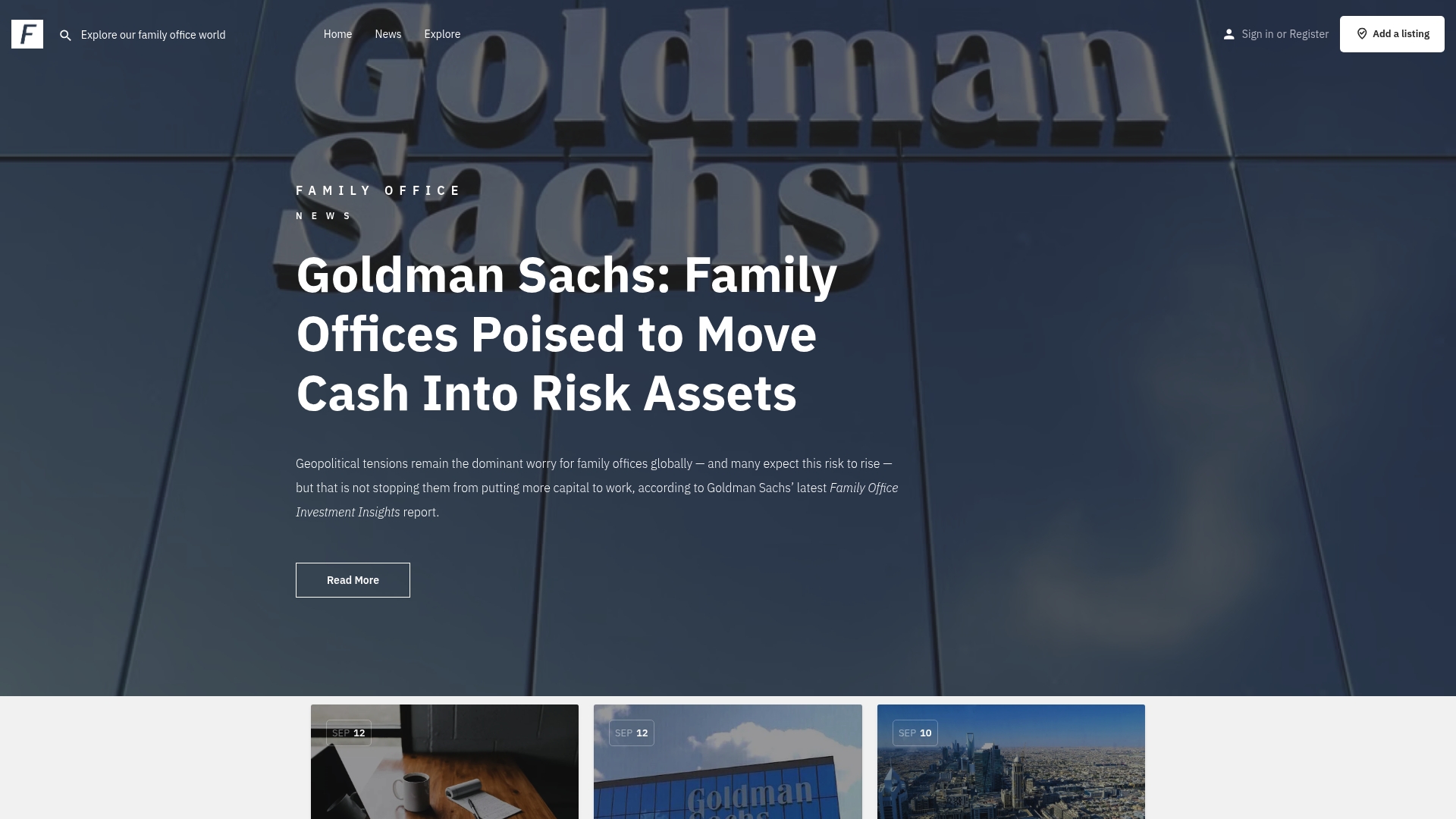Family offices are quietly shaping how the richest families in the world manage their fortunes. Some might think these are just upscale versions of private banks, but the difference is staggering. Single family offices typically appear only when a family’s net worth exceeds $100 million and their methods go far beyond basic investing. The real surprise is how these private financial powerhouses focus on everything from succession planning to philanthropy, building a structural legacy that most standard financial advisors simply cannot touch.
Table of Contents
- Defining Family Offices: What They Are And Their Purpose
- Why Family Office Structure Matters For Wealth Management
- Key Components Of A Family Office: Building Blocks Explained
- Operational Models: How Family Offices Function In Practice
- Trends And Future Of Family Offices: Evolving Landscape
Quick Summary
| Takeaway | Explanation |
|---|---|
| Family offices preserve wealth across generations. | They focus on maintaining and transferring family wealth, ensuring financial legacy protection. |
| Single and multi family offices serve different needs. | Single family offices cater exclusively to one family’s needs while multi family offices serve multiple families collectively. |
| Advanced technology enhances family office efficiency. | Utilizing modern tech tools allows better portfolio monitoring and adaptable financial strategies. |
| Holistic wealth strategies exceed traditional management. | Family offices provide comprehensive strategies addressing investments, taxes, and estate planning in one cohesive plan. |
| Sustainable investing is gaining importance. | Younger generations are increasingly prioritizing investments that are socially responsible and environmentally sustainable. |
Defining Family Offices: What They Are and Their Purpose
A family office represents a sophisticated private wealth management structure designed to handle the comprehensive financial needs of ultra high net worth families. Unlike traditional financial services, these dedicated entities provide holistic, personalized financial management that goes far beyond standard investment strategies.
The Core Purpose of Family Offices
The primary objective of a family office is to preserve, grow, and transfer wealth across generations while protecting the family’s financial legacy. According to McKinsey & Company, family offices have evolved from simple investment management platforms to complex, multifaceted institutions that address a wide range of financial and strategic requirements.
Key functions of family offices include:
- Consolidated investment management
- Tax planning and optimization
- Estate and succession planning
- Risk management and asset protection
- Philanthropic advisory services
Types of Family Offices
Family offices generally fall into two primary categories: single family offices (SFOs) and multi family offices (MFOs). A single family office serves one affluent family exclusively, providing highly customized services tailored to their specific financial landscape. In contrast, multi family offices serve multiple wealthy families, allowing for cost sharing and broader resource allocation.
Single Family Offices typically emerge when a family’s net worth exceeds $100 million, justifying the substantial operational costs of maintaining a dedicated financial management team. These offices offer unparalleled personalization and direct access to financial strategists who understand the family’s unique objectives.
Multi Family Offices provide similar comprehensive services but distribute operational expenses across multiple families. This model enables smaller wealthy families to access sophisticated wealth management resources that would otherwise be financially prohibitive.
Campden Wealth Research suggests that multi family offices have grown significantly in recent years, reflecting the increasing complexity of wealth management for high net worth families.
The family office structure represents more than just a financial service it is a strategic approach to holistic wealth stewardship, designed to protect and enhance a family’s financial ecosystem across generations.
Below is a comparison of Single Family Offices (SFOs) and Multi Family Offices (MFOs) to clarify their distinct characteristics and which types of families they best serve.
| Family Office Type | Serves | Typical Net Worth Threshold | Service Personalization | Cost Structure | Examples of Key Benefits |
|---|---|---|---|---|---|
| Single Family Office | One family exclusively | $100 million+ | Highly customized | All costs borne by one family | Direct access, tailored strategy |
| Multi Family Office | Multiple families | Lower (varies by provider) | Comprehensive, less custom | Shared among families | Access to expertise, cost efficiency |
Why Family Office Structure Matters for Wealth Management
The strategic framework of a family office structure plays a critical role in transforming wealth management from a transactional approach to a comprehensive, generational strategy. Beyond mere financial administration, this sophisticated structure provides an integrated ecosystem that addresses the multifaceted financial challenges faced by ultra high net worth families.
Holistic Wealth Preservation Strategy
A well-designed family office structure enables comprehensive wealth management that transcends traditional investment approaches. According to PwC Global Family Business Survey, families with structured wealth management strategies are 45% more likely to successfully transfer wealth across generations.
Key strategic advantages of a robust family office structure include:
- Comprehensive risk management
- Integrated financial planning
- Cross-generational wealth transfer mechanisms
- Customized investment portfolio development
- Advanced tax optimization strategies
Strategic Financial Intelligence and Decision Making
Centralized Financial Governance represents a fundamental advantage of family office structures. By consolidating financial expertise, reporting, and strategic planning under one umbrella, families gain unprecedented visibility into their total financial landscape. This centralization enables more informed, data-driven decision making that considers the complex interplay between investments, tax implications, and long term family objectives.
Cambridge Associates Research highlights that family offices with sophisticated structural frameworks can potentially generate 2-3% higher annual returns compared to traditional wealth management approaches, primarily through strategic asset allocation and proactive risk management.
Technology and Adaptive Wealth Management
Modern family office structures increasingly leverage advanced technological platforms to enhance financial intelligence and operational efficiency. These technologies enable real time portfolio monitoring, predictive financial modeling, and seamless integration of diverse investment classes. By creating a flexible, technology enabled structure, family offices can rapidly adapt to changing market conditions and emerging investment opportunities, ensuring continued wealth preservation and growth.
Key Components of a Family Office: Building Blocks Explained
A family office represents a complex ecosystem with multiple interconnected components designed to manage comprehensive financial strategies. Understanding these fundamental building blocks is crucial for creating an effective wealth management infrastructure that can adapt and evolve with a family’s changing financial landscape.
Organizational Leadership and Governance
The leadership structure forms the critical foundation of any family office. Deloitte Private Wealth Management Research emphasizes that successful family offices require a carefully curated leadership team with diverse expertise spanning investment management, legal frameworks, tax strategy, and intergenerational wealth planning.
Key leadership roles typically include:
- Chief Investment Officer
- Family Wealth Strategist
- Legal and Compliance Director
- Tax Planning Specialist
- Risk Management Expert
Financial Infrastructure and Investment Architecture
Investment Management Systems represent the operational core of a family office. These sophisticated platforms enable comprehensive portfolio tracking, performance analysis, and strategic asset allocation. Modern family offices utilize advanced technological ecosystems that integrate multiple investment classes, from traditional securities to alternative investments like private equity, real estate, and emerging market opportunities.

The investment architecture must provide:
- Comprehensive portfolio monitoring
- Real time performance analytics
Specialized Professional Support Network
A robust family office requires an extensive professional support network that extends beyond internal staff. This network includes external advisors who provide specialized expertise in areas such as legal compliance, international tax strategy, and complex investment structures. Ernst & Young Global Family Office Guide suggests that successful family offices cultivate relationships with a diverse range of professionals who can provide nuanced guidance across different financial domains.
The support network typically encompasses tax attorneys, investment consultants, international tax specialists, and wealth transfer experts who collectively ensure a holistic approach to financial management and generational wealth preservation.
Operational Models: How Family Offices Function in Practice
Family offices represent sophisticated financial ecosystems that adapt their operational models to meet the unique needs of ultra high net worth families. Understanding these dynamic operational frameworks reveals the intricate strategies employed to manage complex wealth management requirements.
Organizational Structural Approaches
Campden Wealth Research indicates that family offices deploy diverse organizational models, each tailored to specific family dynamics and financial objectives. The operational structure fundamentally determines how financial strategies are developed, implemented, and monitored.
The following table summarizes the primary operational models for family offices, helping you compare their structure, roles, and advantages.
| Operational Model | Internal Resources Used | Outsourcing Level | Typical Advantages | Example Use Case |
|---|---|---|---|---|
| Fully Integrated Family Office | Extensive, in-house staff | Minimal | Full control, high personalization | Families desiring maximum privacy and autonomy |
| Outsourced Family Office | Limited, small internal team | High | Lower fixed costs, access to niche expertise | Families seeking flexibility or cost savings |
| Hybrid Family Office Model | Blend of in-house and third-party experts | Moderate | Best of both worlds, scalability | Families with diverse but evolving needs |
Three primary operational models include:
- Fully Integrated Family Office
- Outsourced Family Office
- Hybrid Family Office Model
Investment Decision Making Mechanisms
Strategic Investment Governance represents a critical component of family office operations. These mechanisms involve sophisticated decision making processes that blend quantitative financial analysis with qualitative family values and long term strategic objectives. Unlike traditional investment firms, family offices integrate personal family considerations into their financial strategy.
Key investment decision making characteristics include:
- Collaborative multi generational input
- Comprehensive risk assessment frameworks
- Alignment with family legacy and values
- Flexible strategic adaptation
Technology and Operational Efficiency
Modern family offices increasingly leverage advanced technological platforms to enhance operational efficiency and financial intelligence. Gartner Technology Research reveals that technology integration allows family offices to create more transparent, responsive, and data driven operational models. Advanced technological ecosystems enable real time portfolio monitoring, predictive financial modeling, and seamless integration of diverse investment classes.
These technological platforms facilitate:
- Enhanced reporting capabilities
- Secure information management
- Cross border investment tracking
The operational models of family offices continue to evolve, reflecting the complex financial landscapes of ultra high net worth families and their need for sophisticated, personalized wealth management strategies.
Trends and Future of Family Offices: Evolving Landscape
The family office ecosystem continues to undergo significant transformation, driven by technological advancements, changing generational perspectives, and increasingly complex global financial landscapes. These dynamic shifts are reshaping how ultra high net worth families approach wealth management and strategic financial planning.
Digital Transformation and Technology Integration
Deloitte Global Family Office Report highlights the accelerating digital transformation within family office structures. Technology is no longer an auxiliary component but a fundamental strategic driver that enables more sophisticated, transparent, and responsive wealth management approaches.
Key technological trends include:
- Artificial intelligence driven investment analytics
- Blockchain enabled secure transaction platforms
- Advanced cybersecurity infrastructure
- Real time global investment monitoring systems
- Machine learning portfolio optimization tools
Sustainable and Impact Investment Strategies
Generational Wealth Philosophy is experiencing a profound shift, with younger family members increasingly prioritizing sustainable and socially responsible investment strategies. Morgan Stanley Sustainable Investing Report indicates that next generation wealth holders are demanding investment approaches that generate both financial returns and positive societal impact.
Emerging investment focus areas include:
- Climate change mitigation technologies
- Renewable energy infrastructure
- Social impact entrepreneurship
- Ethical technology platforms
- Sustainable agriculture innovations
Global Regulatory and Compliance Landscape
Family offices are navigating an increasingly complex global regulatory environment that demands unprecedented levels of transparency and compliance. PwC Global Regulatory Insights suggests that future family offices will require more sophisticated legal and compliance frameworks to manage cross border investments and evolving international financial regulations.
The future of family offices will be characterized by adaptive, technology enabled structures that seamlessly integrate financial performance with broader societal and environmental considerations, representing a holistic approach to wealth management that transcends traditional investment paradigms.
Transform Your Family Office Structure With the Right Strategy
Are you struggling to navigate the complexities of building a truly effective family office structure? As ‘Understanding Family Office Structure Explained in Detail’ explores, coordinating investment management, regulatory compliance, and multi-generational planning can create real stress for family leaders and UHNW investors. You do not have to approach this challenge alone. When you prioritize comprehensive governance, seamless technology integration, and the right professional network, you empower your family office to stand out in a rapidly evolving landscape.

Future Family Office is here to help you bridge the gap between knowledge and action. At Future Family Office, you gain access to a curated community, the latest family office news and trends, and a robust directory of expert service providers. Join now to connect with industry peers, stay ahead of regulatory shifts, and unlock tools for strategic wealth preservation. Your ideal family office structure begins with your next step on Future Family Office.
Frequently Asked Questions
What is a family office structure?
A family office structure is a dedicated entity that manages the financial affairs of ultra high net worth families. To create your own family office, identify your family’s financial goals and assemble a team with expertise in investment, tax, and legal matters.
How do single family offices differ from multi family offices?
Single family offices (SFOs) serve only one affluent family, providing highly personalized services, while multi family offices (MFOs) serve multiple wealthy families, sharing costs and resources. Determine your family’s net worth and needs to decide which model best aligns with your financial strategy.
What are the key components of a family office?
Key components of a family office include organizational leadership, financial infrastructure, and a professional support network. Start by building a leadership team with diverse expertise, including investment management, legal, and tax planning experts.
How can technology improve family office operations?
Technology enhances family office operations by enabling real-time portfolio monitoring, predictive financial modeling, and seamless integration of investments. Consider implementing advanced tools that can streamline communication and reporting for better decision-making.
What strategies can family offices use for wealth preservation?
Strategies for wealth preservation in a family office may include comprehensive risk management, integrated financial planning, and customized investment portfolio development. Evaluate your current financial strategies to identify areas for risk management improvements and tax optimization.
How does a family office adapt to changing financial landscapes?
A family office adapts by leveraging advanced technology and implementing sustainable and responsible investment strategies. Regularly reassess your investment approach and incorporate technology to respond effectively to market changes and evolving family values.
Recommended
- Randel Carlock: Family Businesses or Family Enterprises? – Future Family Office
- What Do Banks Believe Family Offices Should Focus On? – Future Family Office
- Top Five New-Generation Family Office Advisers – Future Family Office
- How can we Prepare the Now Generation of Family Business? – Future Family Office



